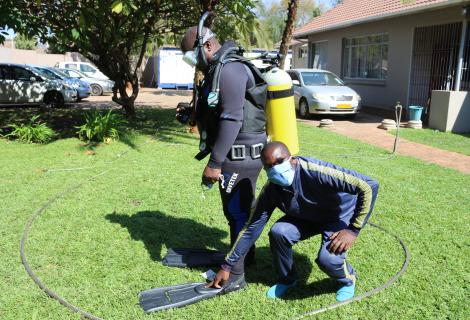Zimbabwe Resilience Building Fund strengthens community resilience

To prepare, respond and recover from floods
The Zimbabwe Resilience Building Fund (ZRBF) has trained the Zambezi Valley communities as well as provided them with water diving equipment to prepare, respond and recover from floods which have over the years affected the community. The three Zambezi Valley districts, namely Binga, Mbire and Kariba/Nyaminyami are prone to flooding.
To address the flooding challenge the ZRBF Zambezi Valley Alliance (ZVA) consortium has organised community-based trainings of three Sub Aqua/water diver units at district level and equipped them with necessary diving equipment to save lives. This was done so that the communities do not to rely on Sub-Aqua teams based in Harare and Bulawayo.
ActionAid is leading the ZRBF- ZVA project consortium which aims to build community resilience to identified hazards and shocks in Kariba, Mbire and Binga districts. The ZRBF Project is a national programme supported by the Ministry of Lands, Agriculture, Water, Climate and Rural Resettlement, the European Union (EU), The Embassy of Sweden, the United Nations Development Programme (UNDP) and the United Kingdom (UK) Department for International Development (DFID). Other members of the ZRBF-ZVA include the African Breeders Services Total Cattle Management (Private) Limited (ABS TCM), Afrosoft Holdings (Private) Limited and Zimbabwe Environmental Law Association (ZELA).
On 21 July 2020, AAZ Head of Programmes and Resource Mobilisation, Andrew Itai Chikowore handed over the water diving equipment to the Zimbabwe Republic Police (ZRP) Sub Aqua Department in Harare. The equipment, which include oxygen tanks, compressors, diving suits and other items used for rescuing people who will have drowned, will be handed over to Mbire, Kariba and Binga ZRP trained Sub Aqua teams so that it benefits Zambezi Valley communities.
ZRBF-ZVA project engaged the ZRP Sub Aqua Unit technical guidance in costing of the needed establishment of three Sub Aqua teams comprising eight water diver per district. This included the training of the teams as well as the required diving equipment to complement their support in the three districts with regards to preparedness, search and rescue in case of flooding. The equipment for the three districts costed about US$44 980.
Vulnerability to floods of the three districts is mainly due to their proximity to the Zambezi River and Kariba Dam which are a big water body. The back flow from Cabora Bassa leading to flash floods in Mbire and other low-lying areas in the Zambezi Valley are perennially experienced by the community. This affects the main livelihood activities for the community which is centred on fishing and livestock rearing.
The need to establish district sub aqua units is in line with the ZRBF project objective of building on existing capacities and interventions to sustainable community resilience. The project works with the District Civil Protection Committees and Ward Resilience Committees in building community capacity to prepare, respond and recover from floods.
Flooding claims lives in the Zambezi Valley and in the agricultural season, 2017/18, more than 50 people drowned in major rivers across the three districts. This necessitated the need for the establishment and equipping of district Sub Aqua units against flooding.